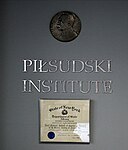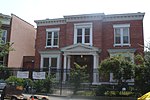The headquarters of Kickstarter, an American public benefit corporation and crowdfunding platform for creative projects, are in Greenpoint, a neighborhood of Brooklyn in New York City. The three-story, open plan building is part of the Eberhard Faber Pencil Factory, which operated in the late 19th and early 20th centuries and was later designated as a historic district.
Kickstarter purchased the building in 2011 after reinvesting US$7.5 million of a venture round to establish a home for the company, a nontraditional investment for an Internet startup but aligned with the company's long-term priorities. The building underwent an extensive renovation between 2011 and 2013. Staff moved from Kickstarter's Lower East Side offices in January 2014 and inaugurated the headquarters several months later with a block party.
Kickstarter's renovation preserved the shell of the building, which was all that remained from its prior owner. The work to restore the façade and retain its arrested decay received two New York-based awards. In the signature sustainable and arboreal style of the renovation's architect, Ole Sondresen, the project adaptively reused the building's frame and recycled other materials sourced locally. Sondresen designed the headquarters around a central, glass courtyard. Designer Camille Finefrock, who also was responsible for the interior design, outfitted the courtyard with native ferns and shrubs. The space includes a rooftop garden, library, 74-seat theater, and was designed to afford staff a variety of workspace options.
The building's street faces are composed of three different façades in graffitied red brick, constructed from right to left, starting with the Italianate style of a factory built in 1860 and purchased by Faber a decade later. Faber hired the Brooklyn architect Theobald Engelhardt to make the center façade in Renaissance Revival style. The easternmost portion was built in the German Romanesque Revival style. The renovators repaired and shored this mismatched façade to preserve rather than overwrite the anachronistic updates it had received since its creation. The façade restorers studied each deteriorated joint to create replacement mortar equivalent in composition.








